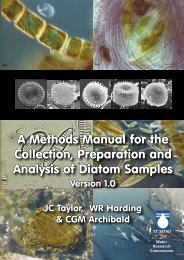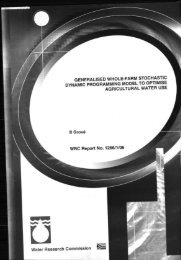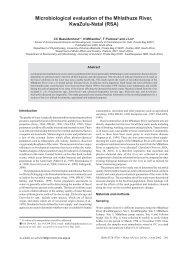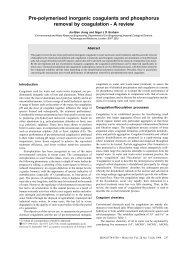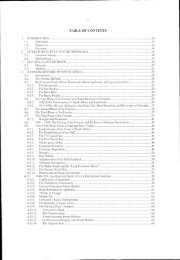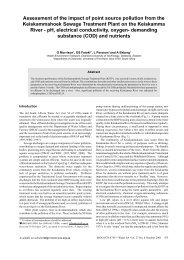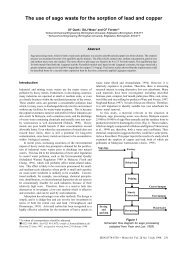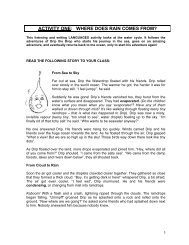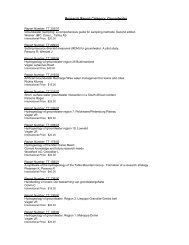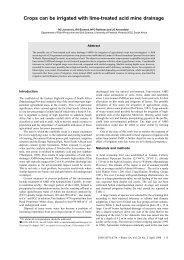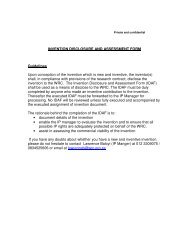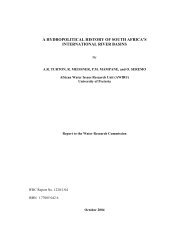and the Efficacy of Pit Latrine Additives - Water Research Commission
and the Efficacy of Pit Latrine Additives - Water Research Commission
and the Efficacy of Pit Latrine Additives - Water Research Commission
- No tags were found...
Create successful ePaper yourself
Turn your PDF publications into a flip-book with our unique Google optimized e-Paper software.
The presence <strong>of</strong> large amounts <strong>of</strong> non-degradable material in a pit has two effects: (i) <strong>the</strong> pit fills<br />
quicker due to <strong>the</strong> large material addition rate <strong>and</strong> (ii) <strong>the</strong> rate at which biodegradable material is<br />
covered over in <strong>the</strong> top layer <strong>and</strong> <strong>the</strong>refore deprived <strong>of</strong> oxygen is increased resulting in lower potential<br />
for aerobic degradation during residence in <strong>the</strong> top layer<br />
The amount <strong>of</strong> moisture present in <strong>the</strong> pit contents will have an effect on both biological <strong>and</strong> transport<br />
processes. Moisture assists in solubilisation <strong>of</strong> potentially soluble components (including salts, easily<br />
digestible organic material <strong>and</strong> carbon dioxide). It allows movement <strong>of</strong> soluble components relative to<br />
stationary solid components (Martin et al., 2003). It also affects <strong>the</strong> concentration <strong>of</strong> dissolved<br />
components: addition <strong>of</strong> water to <strong>the</strong> pit decreases <strong>the</strong> concentration <strong>of</strong> salts <strong>and</strong> organics leached out<br />
<strong>of</strong> solid material. These concentrations may have a significant effect on <strong>the</strong> rate <strong>of</strong> biological activity in<br />
<strong>the</strong> pit, or <strong>the</strong> extent <strong>of</strong> microbial inhibition if <strong>the</strong> latter is caused by a water soluble component.<br />
The presence <strong>of</strong> organic material in <strong>the</strong> pit from e.g. disposal <strong>of</strong> kitchen refuse or addition <strong>of</strong> soil will<br />
contribute to <strong>the</strong> load <strong>and</strong> diversity <strong>of</strong> micro-organisms in <strong>the</strong> pit <strong>and</strong> assist in <strong>the</strong> establishment <strong>of</strong> a<br />
healthy natural micro-organism population in <strong>the</strong> pit provided that pit conditions are conducive to such.<br />
In summary, it is not possible to predict what will be in any particular pit without at least looking into <strong>the</strong> pit, or<br />
digging <strong>the</strong> contents out. Considerable variability may be expected in organics content, moisture content,<br />
non-biodegradable content <strong>and</strong> micro-organism population.<br />
3.2.3 What happens to things in <strong>the</strong> pit<br />
What is added to a pit depends mostly on user habits <strong>and</strong> to a lesser extent on <strong>the</strong> physical design <strong>of</strong> <strong>the</strong><br />
structure. What occurs in <strong>the</strong> pit depends to on <strong>the</strong> same two factors; in addition, <strong>the</strong> geo-hydrology <strong>of</strong> <strong>the</strong><br />
locality <strong>of</strong> <strong>the</strong> pit will also affect <strong>the</strong> processes that occur <strong>the</strong>rein.<br />
An important step in developing a strategy for improving <strong>the</strong> design <strong>and</strong> operation <strong>of</strong> pit latrines is to<br />
underst<strong>and</strong> what processes occur in <strong>the</strong> pit, how <strong>the</strong>y occur, <strong>and</strong> what factors will affect <strong>the</strong> rate at which<br />
<strong>the</strong>y occur. Once <strong>the</strong> processes are understood, it becomes possible to propose methods <strong>of</strong> enhancing <strong>the</strong><br />
processes ei<strong>the</strong>r through <strong>the</strong> addition <strong>of</strong> chemical or biological agents or through simple design changes.<br />
Examination <strong>of</strong> available literature has indicated that certain factors may have a significant effect on <strong>the</strong><br />
performance <strong>of</strong> a pit latrine). These are summarised in Table 3.1.<br />
Table 3.1: Factors that may affect performance <strong>of</strong> a pit latrine<br />
Construction <strong>and</strong> location Operation Maintenance<br />
Construction <strong>of</strong> walls <strong>and</strong> base <strong>of</strong> <strong>the</strong> Age <strong>of</strong> <strong>the</strong> pit<br />
Frequency/history <strong>of</strong> emptying<br />
pit<br />
Permeability <strong>of</strong> <strong>the</strong> walls <strong>and</strong> base <strong>of</strong><br />
<strong>the</strong> pit<br />
addition <strong>of</strong> o<strong>the</strong>r material (e.g.<br />
household waste)<br />
Amount <strong>of</strong> seed material left after<br />
emptying<br />
Construction <strong>of</strong> slab, collar <strong>and</strong> Ingress <strong>of</strong> (non-urine) liquid via <strong>the</strong> <strong>Additives</strong> used to enhance digestion<br />
superstructure <strong>of</strong> <strong>the</strong> latrine<br />
top <strong>of</strong> <strong>the</strong> pit<br />
Height <strong>of</strong> water table (low/high) Rate <strong>of</strong> filling / number <strong>of</strong> users Ownership: Communal or private<br />
Type <strong>of</strong> soil<br />
anal cleansing material<br />
Presence <strong>of</strong> bedrock or s<strong>and</strong>y aquifer<br />
Proximity <strong>of</strong> o<strong>the</strong>r pits<br />
From <strong>the</strong> literature review, <strong>the</strong> following possible effects may occur in <strong>the</strong> pit:<br />
<br />
Accumulation: Material that does not degrade or drain out <strong>of</strong> <strong>the</strong> pit will accumulate <strong>and</strong> cause <strong>the</strong><br />
volume <strong>of</strong> pit contents to increase.<br />
15



